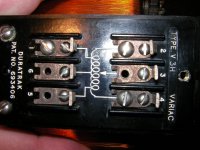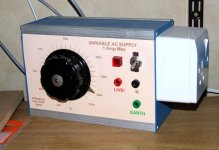Hello Dagwood, AC In = pins 2&4, AC Out = 3&4. Other pins are unused for your usual applications.
Peace,
Dave
Peace,
Dave
Just remember here that you have high voltages on the Variac and it's terminals (240v) in your case, so keep your fingers out of it when you have it plugged in. I would also suggest that you do a quick check with an Ohmeter to make sure that there aren't any shorts that may cause hazards.
Peace,
Dave
Peace,
Dave
Hi Dave
Thanks man
Plan to mount it into a case before powering it up ( safety first! ) just in case of any problems???
Good idea, will check for any shorted turns as well.
Cheers
Ben
Thanks man
Plan to mount it into a case before powering it up ( safety first! ) just in case of any problems???
Good idea, will check for any shorted turns as well.
Cheers
Ben
Hello Dagwood, when you mount it in the case, don't forget a fuse or circuit breaker rated at the maximum current that the variac is rated for. If you want to make it really cool, mount volt meter in the same case so that you can monitor the output quickly. That way your DVM is freed up for other measurements!
Peace,
Dave
Peace,
Dave
Hi Dave
Was just designing front panel in Autocad and thinking the same thing, I like the look of the new blue LCD meters coming out of China ( Ebay again ) but as the Variac has an older style knob and gauge it might look stupid! ??? Think I might look for a retro looking one.
Cheers
Ben
Was just designing front panel in Autocad and thinking the same thing, I like the look of the new blue LCD meters coming out of China ( Ebay again ) but as the Variac has an older style knob and gauge it might look stupid! ??? Think I might look for a retro looking one.
Cheers
Ben
My thoughts. Monitoring voltage is real useful, but I rely on a current meter even more, especially when troubleshooting. And I also prefer analog meters for this, since they are a lot easier to see trends on. If my current meter is oozing up versus rocketing to the sky, that tells me something.
Alternate wiring option
Input 1 -- 4
Output 3 -- 4
What this does is allow you to have more than the line in voltage on the output. You can compensate for low line conditions or test how you electronics reacts to higher than normal line conditions. Very common configuration.
Input 1 -- 4
Output 3 -- 4
What this does is allow you to have more than the line in voltage on the output. You can compensate for low line conditions or test how you electronics reacts to higher than normal line conditions. Very common configuration.
Hi Enzo and Stoc005
See your point on the current meter, I may try to fit both as the case I have is large enough. ( every day is a school day )
Have tested on meter, and your wiring configuration is correct Stoc055, other option would have meant blue smoke! lol
Thank you both for your help
See your point on the current meter, I may try to fit both as the case I have is large enough. ( every day is a school day )
Have tested on meter, and your wiring configuration is correct Stoc055, other option would have meant blue smoke! lol
Thank you both for your help
This is what I did with mine - but then I don't have children around!
file:///C:/Users/cwf/Desktop/myvariac.jpg
file:///C:/Users/cwf/Desktop/myvariac.jpg
Attachments
Last edited:
Dagwood - This is an autotransformer and as such does not provide isolation from the AC line comming into your house. Those bananna jacks on the front are the same as sticking your finger in a light socket. Either go with a standard AC outlet instead of the bananna jacks, or used it with a isolation transformer, or be real carefull. Iknow Iknow your a big boy. 🙂
Thanks for the concern guys.
It's hard to see in the pic but the round white thing to the right of the banana jack is a standard AC outlet which is what I use 90% of the time, in fact I have only ever used the earth socket on the others to connect an ESD wristband. I guessed it was no different from connecting up say a transformer for testing, to a mains lead with a strip connector (I’m sure most will have done that at some stage?)
Anyhow thanks, I have and still will be very careful when she’s up and running.
Cheers
It's hard to see in the pic but the round white thing to the right of the banana jack is a standard AC outlet which is what I use 90% of the time, in fact I have only ever used the earth socket on the others to connect an ESD wristband. I guessed it was no different from connecting up say a transformer for testing, to a mains lead with a strip connector (I’m sure most will have done that at some stage?)
Anyhow thanks, I have and still will be very careful when she’s up and running.
Cheers
Hi,
I see two safer options.
1.) remove the banana terminals and seal off the redundant holes.
or
2.) install a small (100VA transformer?) inside the casing. Connect the primary to the output of the Variac and connect the secondary to the bananas. This gives a variable isolated AC supply. Zero to 30Vac would be possible if you use a 15+15 Vac transformer, either centre tapped or dual secondary.
I see two safer options.
1.) remove the banana terminals and seal off the redundant holes.
or
2.) install a small (100VA transformer?) inside the casing. Connect the primary to the output of the Variac and connect the secondary to the bananas. This gives a variable isolated AC supply. Zero to 30Vac would be possible if you use a 15+15 Vac transformer, either centre tapped or dual secondary.
Hi Andrew
That's probably not a bad idea to put an isolation transformer in for the lower voltages, that way I maintain the convenient earth connection and not fry myself late at night!
Thanks for the ideas
That's probably not a bad idea to put an isolation transformer in for the lower voltages, that way I maintain the convenient earth connection and not fry myself late at night!
Thanks for the ideas
A safe alternative to the "widow maker" terminals is a Safebloc(TM) which provides a much safer way to connect bear leads to the mains voltages. A quick search found this link:
QUICK Test Block - Safe Block Test Adaptor For Electrical Appliances Flexible Cables - PAT Testing Equipment - PAT Testing Adaptors - Quicktest Block - Safetest Block
Not cheap, but then if you have seen the Sigma insurance ads you will know it is a cheaper option (local joke).
QUICK Test Block - Safe Block Test Adaptor For Electrical Appliances Flexible Cables - PAT Testing Equipment - PAT Testing Adaptors - Quicktest Block - Safetest Block
Not cheap, but then if you have seen the Sigma insurance ads you will know it is a cheaper option (local joke).
- Status
- Not open for further replies.
- Home
- Design & Build
- Equipment & Tools
- New Variac


